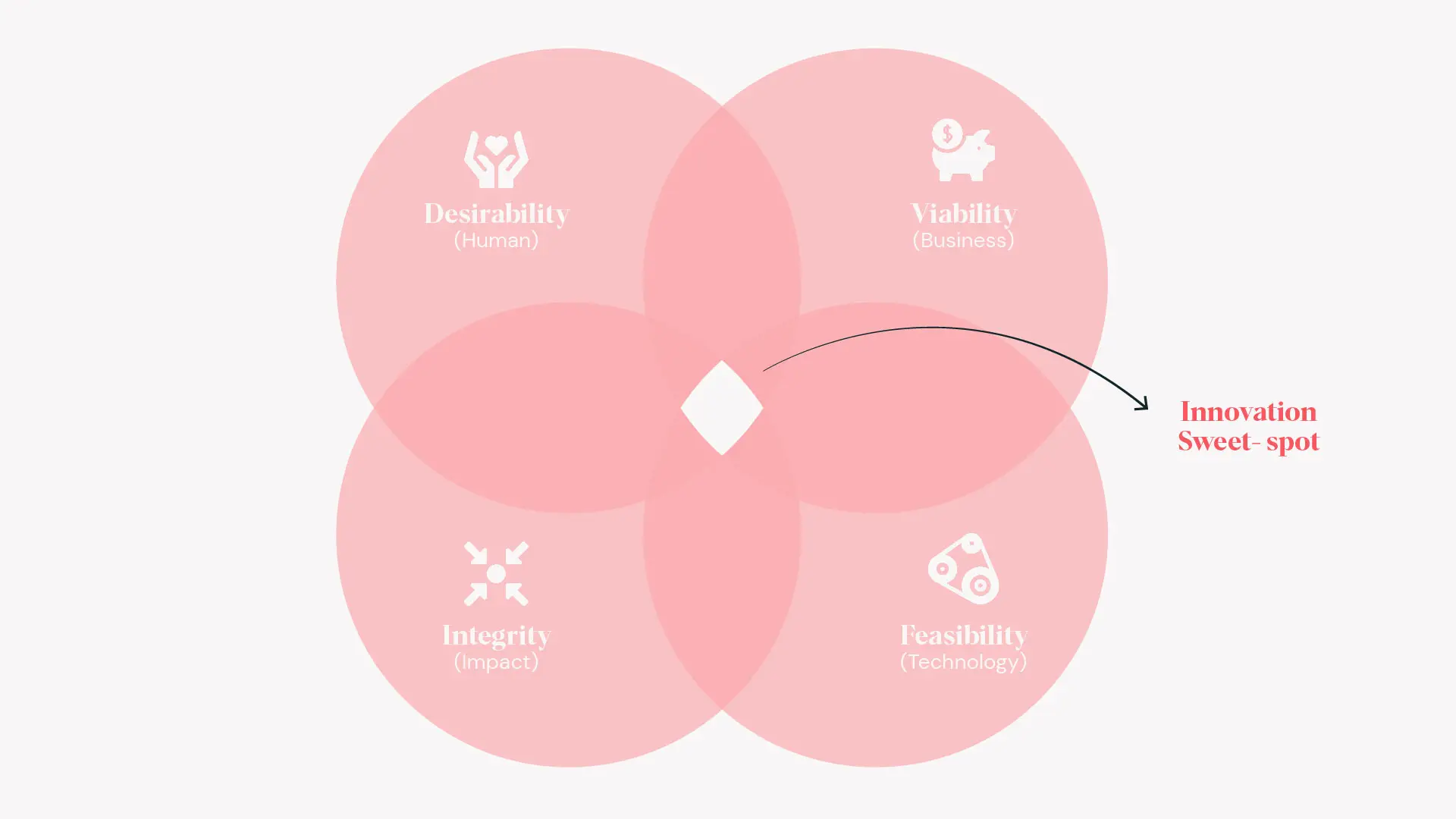Brilliant innovation that hits all the right notes is every company’s holy grail. At Board of Innovation, we like to call it the innovation sweet spot: get it right with your innovation concept and you hit it out of the park. But what exactly is this innovation sweet spot? And what happens if certain conditions aren’t met?
What is the innovation sweet spot?
In a nutshell, here’s what the innovation sweet spot is all about. When innovating, you’ll need to satisfy four different criteria if you want to make it a success:
Are people waiting for this? Does it add value to the lives of your users and consumers?
Is your supporting business model sustainable and can it be scaled?
Will you be able to deliver on your concept, both technologically and operationally?
On a broader level, how does your innovation impact society and the planet as a whole? With the massive ecological challenges ahead, this criterion can no longer be overlooked and should be at the heart of your innovation thinking.
Is it necessary to tick all the boxes?
There’s no getting around it. These four criteria are equally crucial to your innovation concept. Leave one out, and it might come tumbling down like a house of cards.
You will either fail to attract customers (desirability), go bankrupt (viability), fail to deliver (feasibility), or experience pushback from regulatory bodies, media or the public – and of course, you’ll be on the wrong side of history (integrity).
What does that look like in practice?
Now that we’ve covered the basics, let’s zoom in on a few cases to illustrate the point. Each one of the following examples falls short in one or more areas and is therefore at risk of being unsustainable in the long run, unless the companies behind those products are able to successfully redefine their solutions to meet each of the four criteria – and ultimately hit the innovation sweet spot.
Here are some examples:
Example 1
The desirability driver of water bottles is as clear as the liquid in them: providing clean water in a convenient way for customers. These products have proven to be highly viable, since they create recurring revenue for the manufacturer. However, if you look at the more eco-friendly alternatives, such as Dopper, you will see that this is not the case – customers buy one bottle and continue to fill it, drying up any recurring revenue streams.
The feasibility of the concept is outstanding as well: it is relatively cheap and easy to produce, thanks to ever evolving plastic bottling technology. But the catch is clearly the integrity aspect: the product’s negative impact in terms of waste and resources, as well as other SDG objectives, puts it at odds with maturing environmental and climate laws.
Water bottle producers face many challenges, and unless they meet the public’s expectations for durable, nature-friendly and zero-impact alternatives, they might suffer regulatory consequences in the not-so-distant future.
Example 2
The desirability driver of pregnancy tests is, of course, to provide women with early information on a possible pregnancy, in the privacy of their own home. But as this case proves, not every innovation criterion is as black and white as one might think. Sometimes there’s even tension surrounding a single criterion.
Let’s set aside feasibility and viability for a moment and focus on the integrity criterion, based on the UN’s Sustainable Development Goals – or SDGs.
From this point of view, the disposable nature of the test creates a negative impact as a result of the single use of disposable electronic and plastic parts. At-home pregnancy tests contribute to landfill waste and the depletion of resources.
Needless to say, these types of tests significantly improve health care opportunities for women and their babies, by allowing women to seek antenatal care at an early stage of their pregnancy.
By providing women with early-stage information about their pregnancies, these tests facilitate family planning and afford women greater control over their lives and reproductive rights.
How can manufacturers resolve this tension in the long run?
Good question. Let’s answer it.
Don’t mix up the criteria
If a product has a positive impact, it can be impossible to weigh the different criteria against each other. If there’s a need for it, there’s a need for it – the product not being circular won’t change that for now. All morality aside, if its desirability is clear, customers will still see and experience the added value of the product.
Measure what matters
Set success metrics for each individual criterion. If your product has already launched, reflect on each criterion independently and evaluate current performances. If you’re running a start-up without current customers, map your assumptions and facts (where available) on each criterion.
Set your goals
Determine what needs improving and what is positive regarding each individual criterion. Summarize the overall challenge for your business and pinpoint what you need in order to hit the innovation sweet spot. Which criterion
do you need to improve on, and which ones
are just fine?
Lean does it
Adopt a start-up approach and experiment as much as possible. Get feedback, fail fast and iterate your business model until you strike win-win-win-win.
How does that work exactly?
Ok, let’s go back to the pregnancy test case and look more closely at each of these recommendations:
Evaluating whether the positive criteria of the tests trump the downside in terms of integrity is pointless. Addressing both desirability and integrity at the same time is reductionist. It overlooks the value these tests have for women worldwide and their positive impact. Your opinion as an innovator doesn’t matter; this isn’t the place for moral high ground. Instead, separate the two. Yes, from a circulatory perspective these tests are problematic. But that doesn’t mean that the other criteria don’t matter. Determine what needs to be improved (integrity) and what needs to be maintained (desirability).
Now, formulate a clear strategy to envisage innovative, more impactful solutions without affecting the level of desirability of the product. You might ask yourself:
How can we enable women to check their pregnancy status at home, in an environmentally friendly way?
Or, if you are looking to shift the “at home” side of things:
How might we be able to enable women to privately check their pregnancy status in an environmentally friendly way?
There’s a lot more to say about this. Delve into our latest report on the circular economy and read all about the impact perspective. It provides a shortlist of KPIs, to help you ensure your business’s positive circular impact.
What is the key takeaway?
Keep innovating! If you identify any shortcomings around one criterion, try to improve on these without impacting the other three criteria.
Do you have any complex examples yourself? Don’t hesitate to share them with us!






